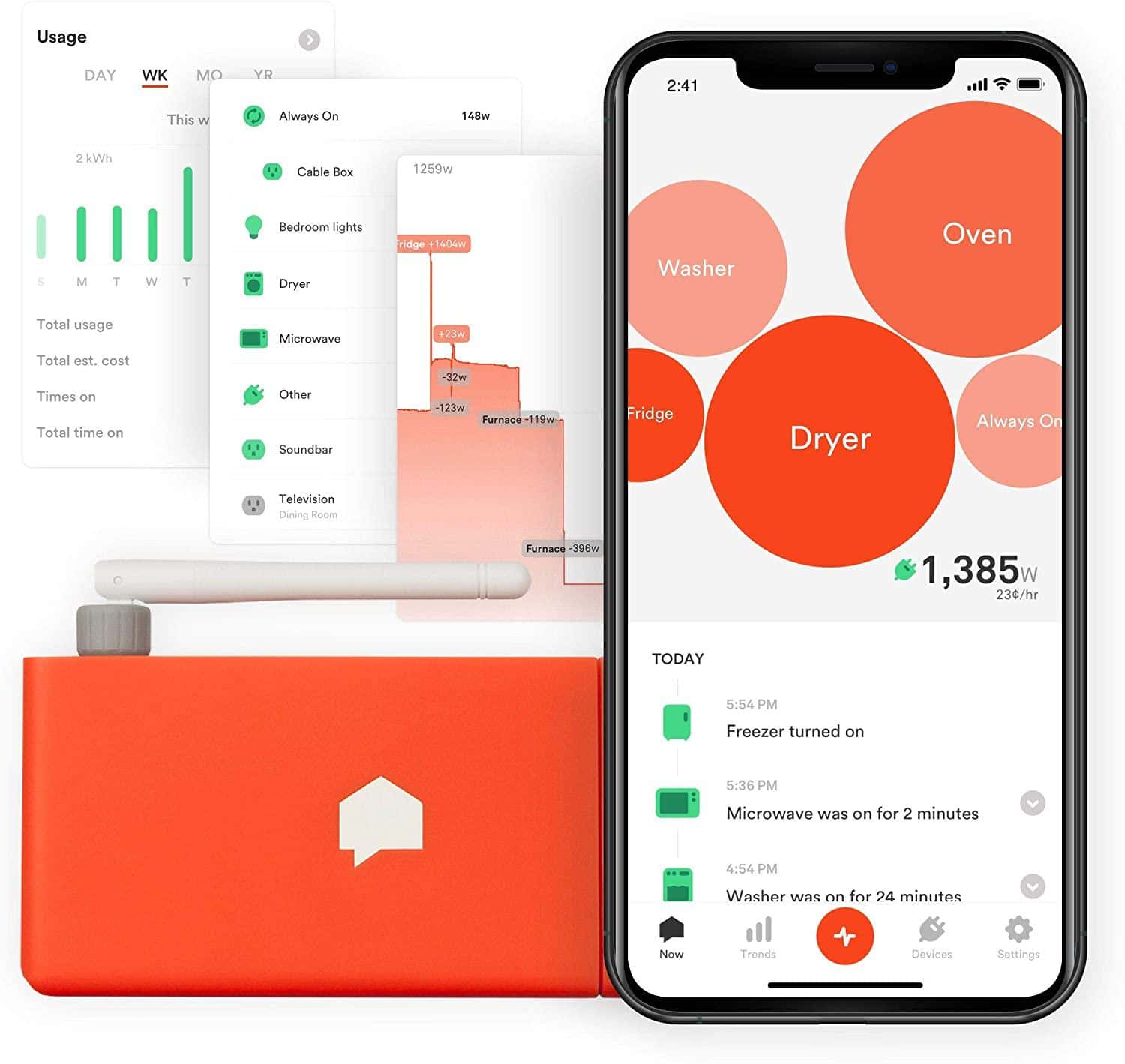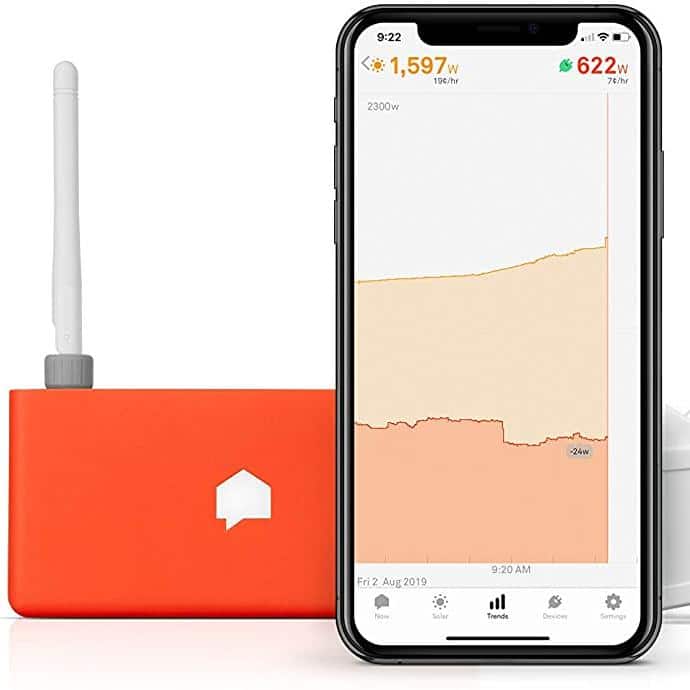

Westend61 / Getty Images
An energy monitor provides detailed information about your home’s power consumption, equipping you to make informed energy-efficiency decisions. The Sense energy monitor allows users to track real-time consumption of the entire home, even down to individual appliances.
With an energy monitor like Sense, you can pinpoint energy sinks in your home and make decisions to become more efficient and save money on power bills. Plus, if you have a home solar system, you can monitor your solar panel power output.
But is this smart home energy monitor the best on the market? Let’s take a deep dive into Sense.
How Does the Sense Home Energy Monitor Work?
The Sense energy monitor uses machine learning to detect individual devices and appliances by identifying their electrical signals. Sense tracks the energy usage of these devices and sends the information to its smartphone app via built-in Wi-Fi, giving you on-demand, real-time usage data.
Sense is proven to be 99.5% accurate, compiling millions of measurements every second to provide useful, up-to-the-minute data about your home’s and appliances’ energy consumption. Sense also identifies trends by day, week, month and billing cycle to demystify nebulous electric bills and show you ways you can save. The monitor can help you along in your journey toward energy efficiency, setting targets by device, day or month, and in watts or dollars.
But Sense does more than put data about your home’s energy usage within your grasp. It allows you to see which devices are on and which are off, such as if the garage door opens, the downstairs clothes dryer is done or you left your oven on. If it’s raining cats and dogs, you can tell immediately if your sump pump is working, sparing a potential disaster. And it does all of this remotely, sending information to your smart device wherever you are, from the loo to Timbuktu.
Installation
Sense plugs directly into your home’s circuit breaker box, where it takes up inconspicuous residence to work its magic. Installing the Sense home energy monitor is a straightforward process that usually takes less than 30 minutes for a licensed electrician to complete (Sense highly recommends homeowners hire a professional for the job).
If you’re confident in your electrical skills or just want to know how installation works, here are the steps:
- Turn off the main breaker and remove the electric panel cover.
- Place the Sense monitor inside or outside of the electric panel.
- Feed the antenna through the panel and into monitor ports.
- Clamp the sensors around the two electrical mains, then connect sensors to the Sense monitor.
- Connect Sense’s power cables to an unused but live 240V breaker.
- Close the panel and turn the main back on.
- Install the app and set up an account.
If you are comfortable doing the above, you don’t need anything but a screwdriver to install Sense. If you don’t have an unused 240V breaker, you will need to install one. If you have any doubts, hire a professional.
How Sense Monitors Energy Use and Appliances
Most electronic devices have a unique way they use electricity. Sense takes information on wattage, electrical resistance and other signals, combining them into a cohesive electronic signature used to identify individual devices.
Sense detects many common household appliances such as light bulbs, toasters, washers and dryers, entertainment systems, computers, ovens, water heaters, fridges and more. It can also monitor two 120V or 240V circuits directly and, with optional Flex add-on sensors, can monitor large loads and critical devices like HVAC systems, electric vehicle chargers or pumps.
Does an Energy Monitor Save You Money?
A monitor alone won’t save you money, but changing your habits will. All that the Sense Home Energy Monitor does is provide accurate electricity usage data to help you identify energy inefficiency, make informed decisions and track your progress toward energy reduction goals.
An energy monitor is a great way to discover power-hungry appliances that may be perniciously stealing energy. This may be a device that you forgot to turn off, an always-on appliance that consumes more electricity than you’d expect or something that isn’t operating properly. Such energy hogs can easily go unnoticed but will show up loud and clear with a monitor like Sense.
Sense reports its average user saves 9% on electric bills. Given the average monthly electric bill is $117, or $1,400 per year, Sense saves the average homeowner $126 annually and will pay for itself in about two and a half years.
Using Sense With Your Solar Power System
Sense Solar provides information to optimize solar energy use. The Sense Solar energy monitor offers the same advantages of the base unit, plus other perks specifically tailored to sun-powered electricity, including:
- Real-time and historical solar production readings contrasted versus usage, so you know when to use heavy-load devices or decrease consumption
- Net metering data
- How much energy you pull from the grid versus produce with your panels
If you don’t have a solar monitoring app available from your solar installer or manufacturer, Sense Solar is a great third-party add-on to keep track of the amount of energy your panels produce.
Sense Energy Monitor Reviews
This all may sound great, but what do actual customers have to say about the smart home device’s longevity and ease of use?
The Sense Home Energy Monitor has a 4.3 out of 5-star Amazon rating with over 2,000 reviews. The Sense app has a 3.4 out of 5-star Google Play Store rating with 454 reviews and an App Store rating of 4.1 out of 5 with 256 reviews.
Positive Sense Energy Monitor Reviews
Customers love Sense’s real-time, accurate data helping them make effective decisions to increase their home energy efficiency. Here’s what happy customers are saying in Sense energy monitor reviews:
“I love technology, but this has exceeded my expectations. It was very easy to install, and in 15 minutes, I knew exactly how many watts my home was using… I purchased this to understand my daily energy usage, as I was upgrading my portable emergency generator but really didn’t know where to begin in calculating every plug, refrigerator, freezer, light bulb in my home. This was perfect for knowing exactly what I needed.” — Dan Wood via Amazon
“The fact that it can recognize the change as soon as it happens and reports it goes a long way in understanding the inefficient appliances in your home. Whether it’s bulbs or old appliances it’ll measure it as precisely as anything out there.” — Taiwo E. Egun via Amazon
Negative Sense Energy Monitor Reviews
There are a few naysayers, though. Some folks have found Sense to have issues with device detection and consistent monitoring:
“Very disappointed. Really was hoping this unit would give a better breakdown of my power usage. We’ve had it for 14 months now and over 50% of all our power usage is still not being tracked.” — April Hope via Amazon
“While this product seems to be an answer to energy conservation, it does not live up to its potential. When I had an electrician install it, the first few weeks were fun watching it detect various devices. However, the ability to manually label or add devices was a challenge. After 5 months, it still has not ‘detected’ our washer/dryer. On the timeline, it clearly shows a spike when those units are on, but you are unable to label those and need to wait for the system to detect it.” — ScubaSteve260 via Amazon
Is Sense the Best Home Energy Monitor for You?
The Sense energy monitor is a fantastic performer, giving accurate, instant information as broad as an entire house and narrow as individual appliances and devices. But that doesn’t mean it’s the best option for you, particularly if budget is a primary concern. Starting at just under $300, Sense is definitely an investment, especially considering its competitors’ devices are usually half the price.
Sense is close to perfect, but not completely. Sense hasn’t successfully mapped every single device out there, meaning there may be an elusive anomaly of an appliance somewhere in your home that Sense can’t identify. Plus, some folks report inaccuracies even on common appliances like dishwashers.
But the naysayers are definitely the exception to the rule. The vast majority of customers agree that no other home energy monitor provides the pinpoint precision, accuracy and speed that Sense does. If you have the money and need for a powerhouse home energy monitor, Sense just makes sense.
Sense Energy Monitor

Sense / Amazon
The Sense Energy Monitor provides real-time, 24/7 data that is accessible through iOS, Android and desktop apps. That means you can check energy usage patterns whenever and wherever you like. Even better, schedules and alerts can be set to create a truly customized data system.
Sense Solar

Sense / Amazon
Like the Sense Energy Monitor, Sense Solar can track usage data in real-time. It can also track your appliances and devices on an individual basis to give you a more comprehensive window into your home’s energy consumption.
Christian Yonkers is a writer, photographer, filmmaker, and outdoor junkie obsessed with the intersectionality between people and planet. He partners with brands and organizations with social and environmental impact at their core, assisting them in telling stories that change the world.

 233k
233k  41k
41k  Subscribe
Subscribe 